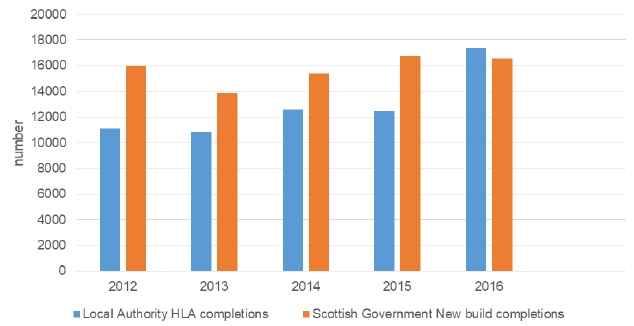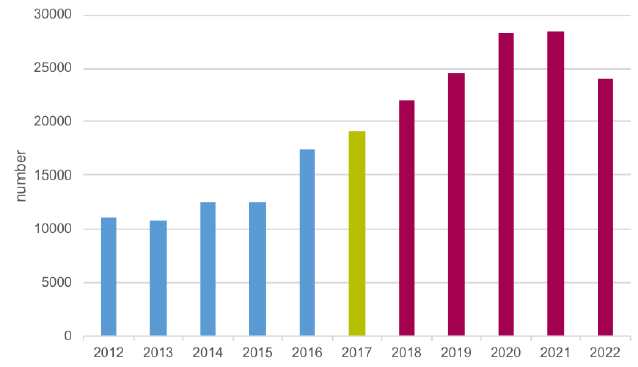Housing land audits: research project
Assessment of housing land audits (HLAs) for consistency and compliance, their potential for standardisation and their role in development plan delivery.
3 Analysis of Housing Land Audits
Introduction
3.1 Scottish local planning authorities produce a full suite of Housing Land Audits (HLAs) across the country. In seeking to identify best practice as well as helping to improve quality and consistency, the methodologies and outputs associated with these HLAs provide a comprehensive baseline analysis.
3.2 The spreadsheet at Appendix 3 summarises the content and outputs of all current HLAs prepared by Scottish local planning authorities. The column headings are primarily derived from current advice on the role and content of HLAs contained within Planning Advice Note 2/2010. The analysis also gives due cognisance to Draft Planning Delivery Advice – Housing and Infrastructure. Although ultimately withdrawn, it does provide recent insight into the role and purpose envisioned for HLAs by the Scottish Government. Both documents identify objectives and key variables, which a HLA should deliver. The column headers ‘Latest Published Version’ and ‘Interactive Mapping’ are not specific requirements of Scottish Government advice and are included by Ryden.
3.3 Against this background, HLAs are required to report the following information:
- All land with permission for housing including remaining capacity;
- Land allocated for housing in the adopted LDP, and
- Land with agreed potential for housing (proposed in draft LDP/capacity study).
3.4 Advice also identifies a set of variables for which information should be provided within HLAs:
- Site name;
- Reference/development plan reference;
- Location/address/grid reference;
- Site area;
- Capacity (total/remaining of those under construction and 5-year supply);
- Site Ownership;
- Planning status;
- Completions (annual - past and projected);
- Nature of site (greenfield or brownfield/ previously developed);
- Number/type housing provided;
- Tenure, and
- Constraints (including type and remedial actions proposed to overcome it).
3.5 Further to the above, the specific objectives for HLAs are to:
- Monitor effective housing land supply;
- Identify constrained sites and actions to overcome those constraints;
- Identify past and future completions;
- Justify sites to be de-allocated due to continued constraints;
- Identify sites already completed within the plan period;
- Clarify engagement with developers, agencies and infrastructure providers;
- Make the HLA available in electronic format.
3.6 The review of the content and output from HLAs has been undertaken against the background of these objectives and key variables as specified by Government advice.
3.7 A ‘traffic light’ system has been used to grade the content of HLAs. Those with a green rating adhere strictly to Scottish Government advice. An amber rating identifies a variation on a particular requirement, while a red rating is used where variables are omitted or are not specified. The full HLA spreadsheet with summary comments is provided in Appendix 3 (the spreadsheet is large and requires to be viewed on screen at 300% or printed on A3 paper). The R.A.G. classification deteriorates moving across the diagram from basic site information to site effectiveness, development and delivery considerations.
Review
3.8 Generally, the majority of HLAs are consistent in providing the more basic and factual details required which allow the identification of a site’s location, size, capacity, planning status, LDP reference, owner and/or developer and the historic/projected completions. There are however some inconsistencies within the basic information provided with a number of HLAs (circa 30%) not specifying whether a site is brownfield (previously developed) or greenfield. There are also a number of HLAs which are historic, i.e. not published in 2017, although the lighter touch requirements for HLAs in rural areas may explain some of those.
3.9 Most, but not all, HLAs identify the tenure of housing. Those that do simply differentiate between private and affordable housing. Some HLAs identify tenure across both completions and projections. Others specify tenure for completions only. A number simply identify the proportion of the total units allocated for affordable housing, with no indication of where they sit in the future programme.
3.10 Very few specify the types of housing proposed, for example, flats or houses.
3.11 The majority of HLAs (68%) are prepared on the basis of defined housing market areas. Others identify housing by settlements and only a very small proportion under a single local authority market area. All HLAs are available electronically.
3.12 There is inconsistency around the reporting of engagement with other public agencies, the development industry and developers/landowners. The majority of HLAs either do not specify whether any engagement has taken place (this does not necessarily mean there has been no engagement), or only clarify engagement with some of the bodies identified in Scottish Government advice. Only a minority of HLAs (32%) clearly identify engagement and consultation with a specified range of consultees.
3.13 Very few (13%) HLAs identify the particular constraints associated with a site as well as the actions required to remove those constraints. Indeed, the majority of audits (61%) do not identify the nature of constraints associated with a particular site and instead simply note where a constraint exists. The remaining 26% do clarify the nature of site constraints, but offer no remedial actions.
3.14 Only 26% of the HLAs specifically identify those sites, which have been removed from the previous audit. Those HLAs identifying removed sites also specify the reasons for those actions. The remaining 74% of the HLAs do not provide any information concerning sites removed from the previous audit.
3.15 35% of HLAs are accompanied by interactive mapping allowing the user to access a site’s detailed information. However, the quality and level of detail within those HLAs varies significantly from an online ‘story map’ format to basic site information accessed by clicking on a particular site.
3.16 Small sites are treated in a range of ways by HLAs. Approximately half of HLAs either include small site completion within their aggregate figures, or show these separately. Some HLAs also indicate programmed completions for small sites. The balance of HLAs either do not monitor small sites or do not say whether they are included.
3.17 Scotland’s two National Park planning authorities rely upon their constituent local authority areas’ HLAs. Cairngorms National Park is identified within the relevant local authority area HLAs – Highland, Aberdeen City and Shire and Perth & Kinross – but The Park does not contribute to those HLAs’ figures. Loch Lomond and Trossachs National Park data is mixed; the Perth & Kinross HLA does include Park data, but the Stirling HLA excludes it. Separately, the National Park planning authorities’ Action Plans/Programmes do include housing sites.
Comment
3.18 There are clear, numerous and significant inconsistencies with regard to the content of, and outputs from current HLAs and their adherence to the variables and objectives set out in Scottish Government advice.
3.19 All HLAs provide sufficient information to monitor the effective supply of housing land and provide a snapshot of the amount of land available for construction at any particular time. However, as detailed in Appendix 3, there are a significant number of current HLAs, which do not identify all of the variables or address the objectives identified in advice.
3.20 The most significant deviation from the information required and lack of consistency between audits generally relates to three particular issues, namely:
- Identifying constraints and how they can be remediated;
- Clarifying the extent of consultation during the audit process;
- Identifying sites removed since the previous HLA.
3.21 The information regarding site constraints and remedial actions is important to the relationship of a HLA with an LDP Action Programme, and thus to site effectiveness (or the actions required to make a site effective). The lack of information or detail further suggests that most HLAs are not as useful as they could be in tracking and supporting site progress through the planning system into delivery of development.
3.22 Despite the levels of inconsistency and deviation from Government advice identified across the full suite of current Scottish HLAs, there are some excellent examples of compliance and consistency.
3.23 The HLAs prepared by Aberdeen City and Shire [15] and Edinburgh City Council [16] are highlighted here as exemplars. The HLA documents produced by these authorities not only cover the more basic details required, but are also thorough in undertaking and setting out their engagement processes, clearly identify those sites removed from the previous audit, and also provide extensive information regarding the specific constraints associated with any given site. They also identify remedial actions and a timescale for the likely removal of those constraints. Since 2016, the Edinburgh Housing Land Audit has been replaced by the Edinburgh Housing Land Audit and Delivery Programme, which reports both the effective housing land supply and the programmed delivery of housing units.
3.24 A further example of good practice includes the full and consistent analysis and established consultation process undertaken by Stirling Council [17] in the production of its annual HLAs, and the presentation of the results both in detailed format and in a dashboard summary.
3.25 Also worth highlighting is the proportionate approach to small and rural markets undertaken by Argyll and Bute Council[18], helpfully illustrated in its online ‘story map’.
National HLA
3.26 The inconsistencies highlighted above make it difficult to present an aggregate, Scottish-level analysis of the housing completions and programmed building contained in the country’s HLAs.
3.27 As a starting point for a national HLA, housing completions data is monitored on a quarterly basis by the Scottish Government using established and consistent definitions. These are shown on Figure 1 (orange bars) for 2012 to 2016. Presented alongside this national data is the total numbers of completions indicated in the current suite of HLAs. The principal gap between the two datasets, evident from 2012 to 2015 inclusive, is the absence of historic housing completions data from five of the HLAs and partial completions data from two others. The two analyses align more closely in 2016 and remaining differences should be explicable in terms of different approaches, for example, the treatment of small housing sites.
Figure 1: Housing Completions according to Scottish Government compared to the completions predicted by local authority HLA (Housing Land Audit), 2012-2016.

3.28 Figure 2 repeats the total HLA completions, then extends the analysis through 2017 to 2022 via the total housing numbers programmed in the HLAs. 2017 is based upon a mix of reported completion or programming where the 2017 data is not yet published (16). Projections in HLAs are mainly annual, although some are not broken down annually and have required assumptions to be made here.
3.29 The growth in projected house building is rapid on Figure 2. As above, historic completions to 2015 are incomplete, and thus are too low. Taking 2016 as a consistent starting point, the compound growth in house building to 2020 indicated by the HLAs exceeds 10% per annum, peaking in 2020 and 2021 at above 28,000 units in each year. This may be a slight underestimate due to the incomplete nature of the base HLA data. Programmed growth is not uniform across local planning authorities and is driven by some indicating completion rates up to double (or more) their peak rates 2012-16. The components of this rapid growth would require a very detailed assessment to fully understand, but could be speculated as continued recovery in the private house building sector, the Scottish Government’s major affordable housing programme, and potentially continuation/ opening-up of sites not built-out in previous HLA periods.
Figure 2: Housing Completions and projections from 2012 to 2022

Contact
Email: Deborah McLean
There is a problem
Thanks for your feedback